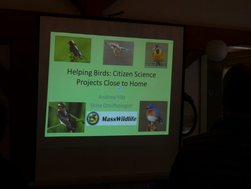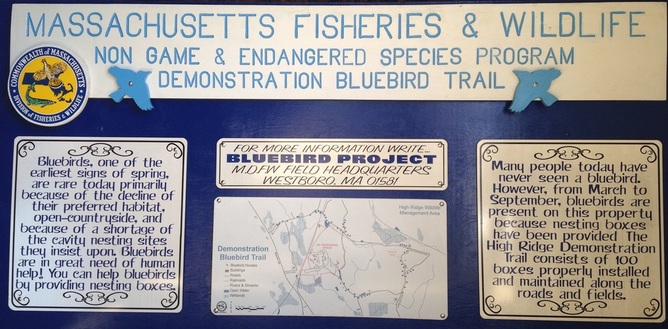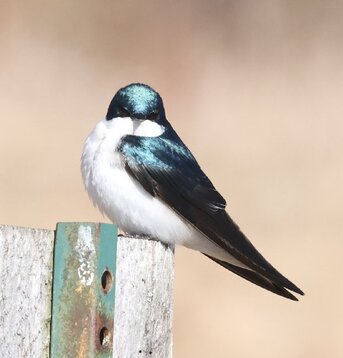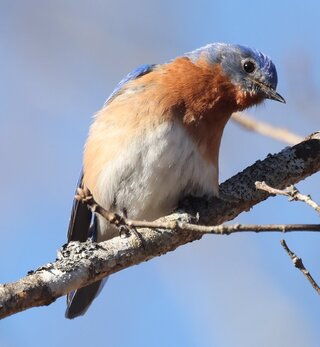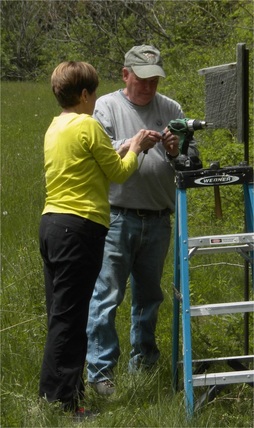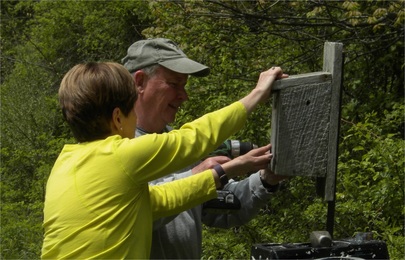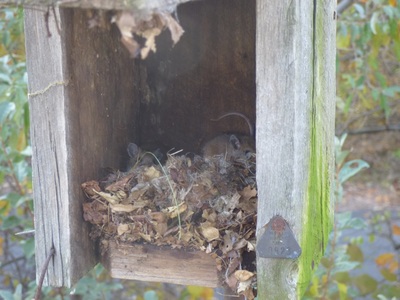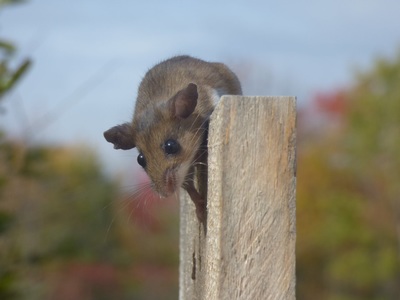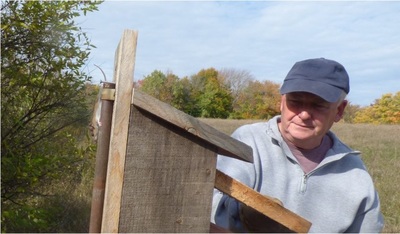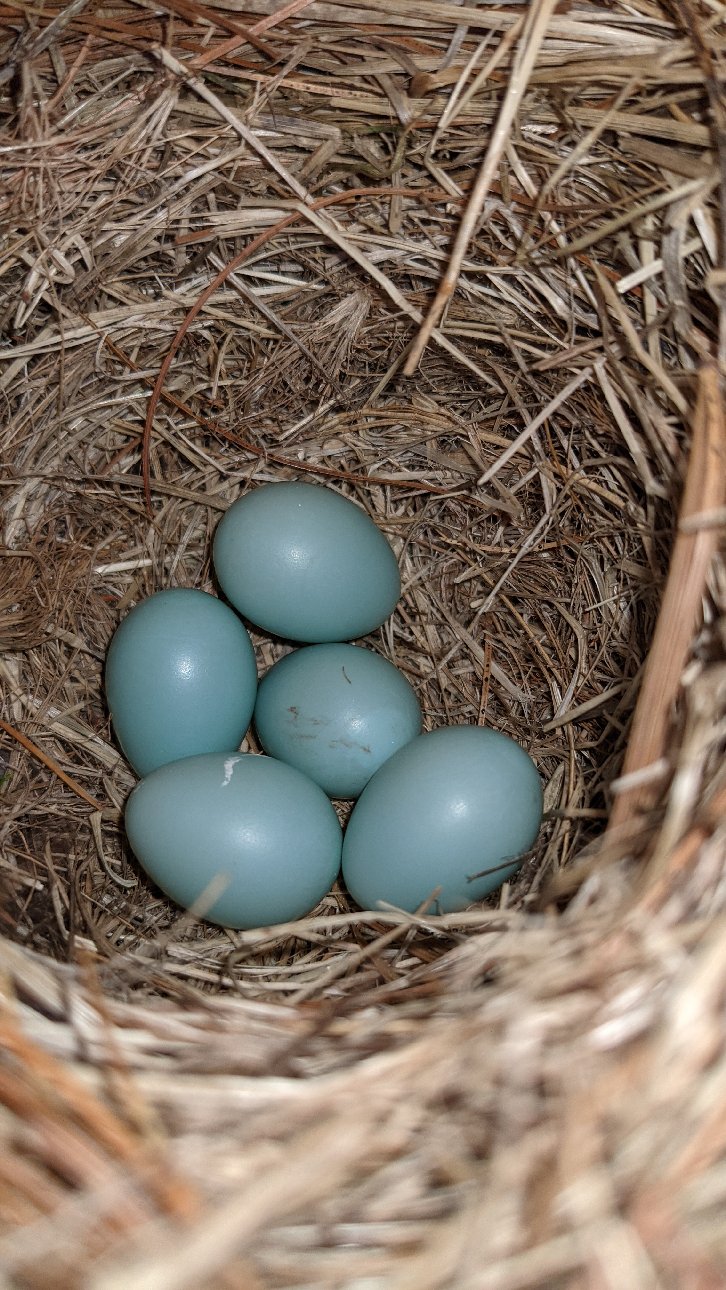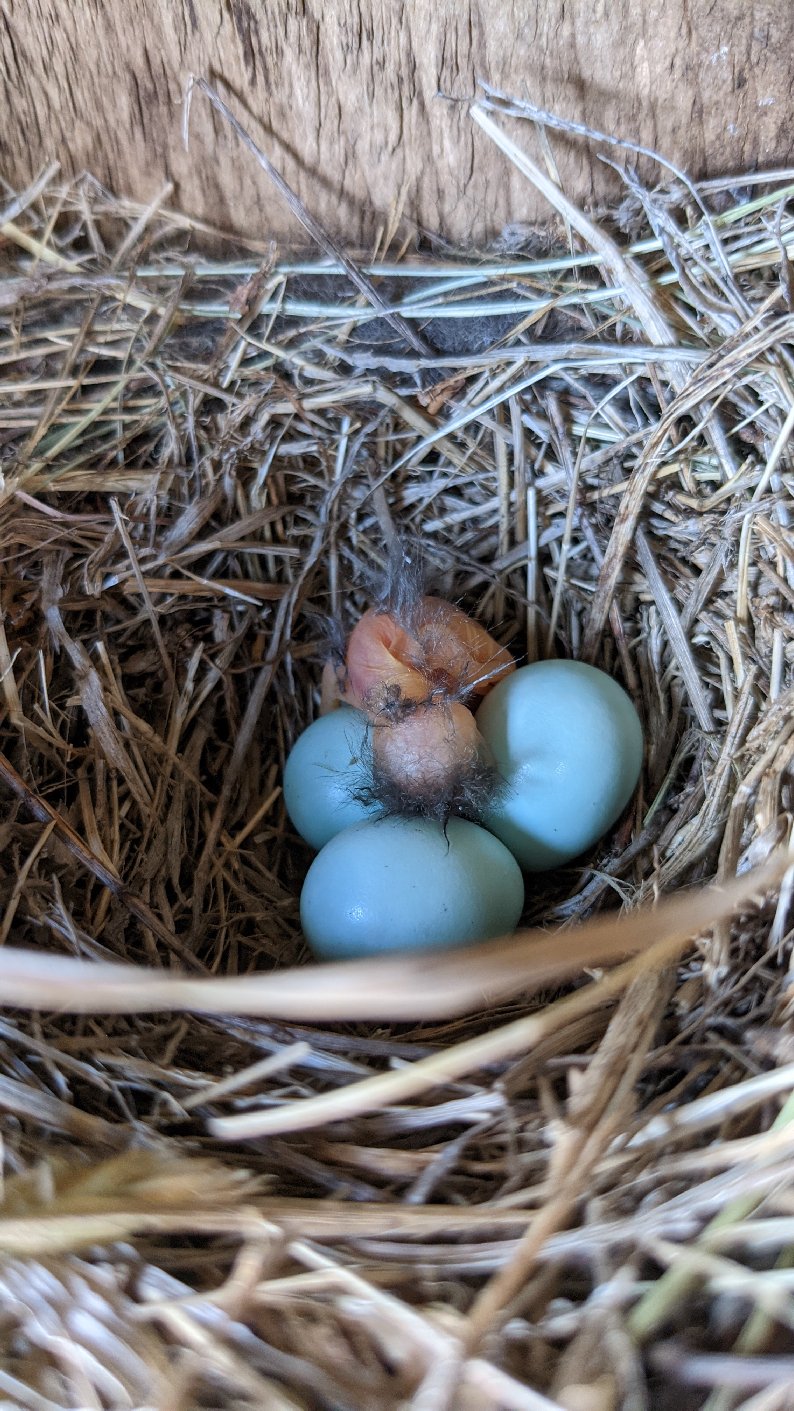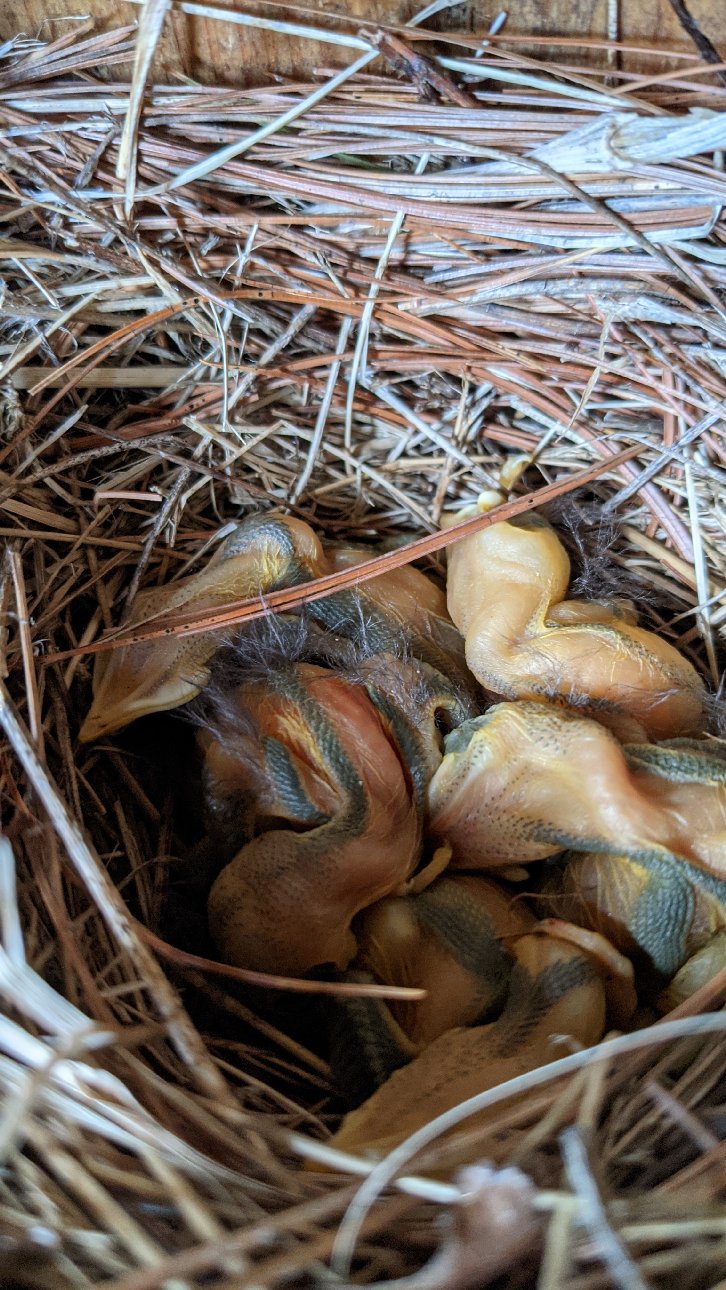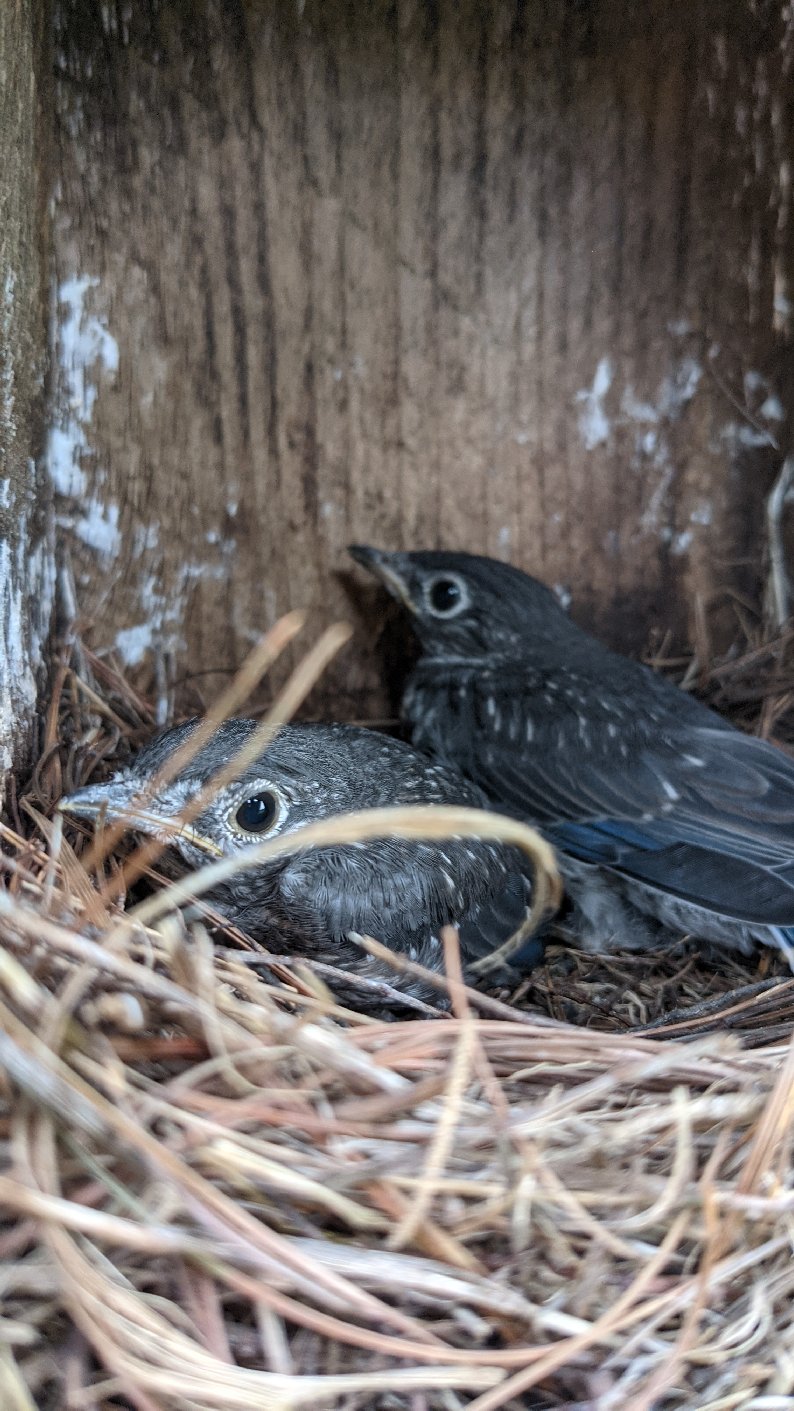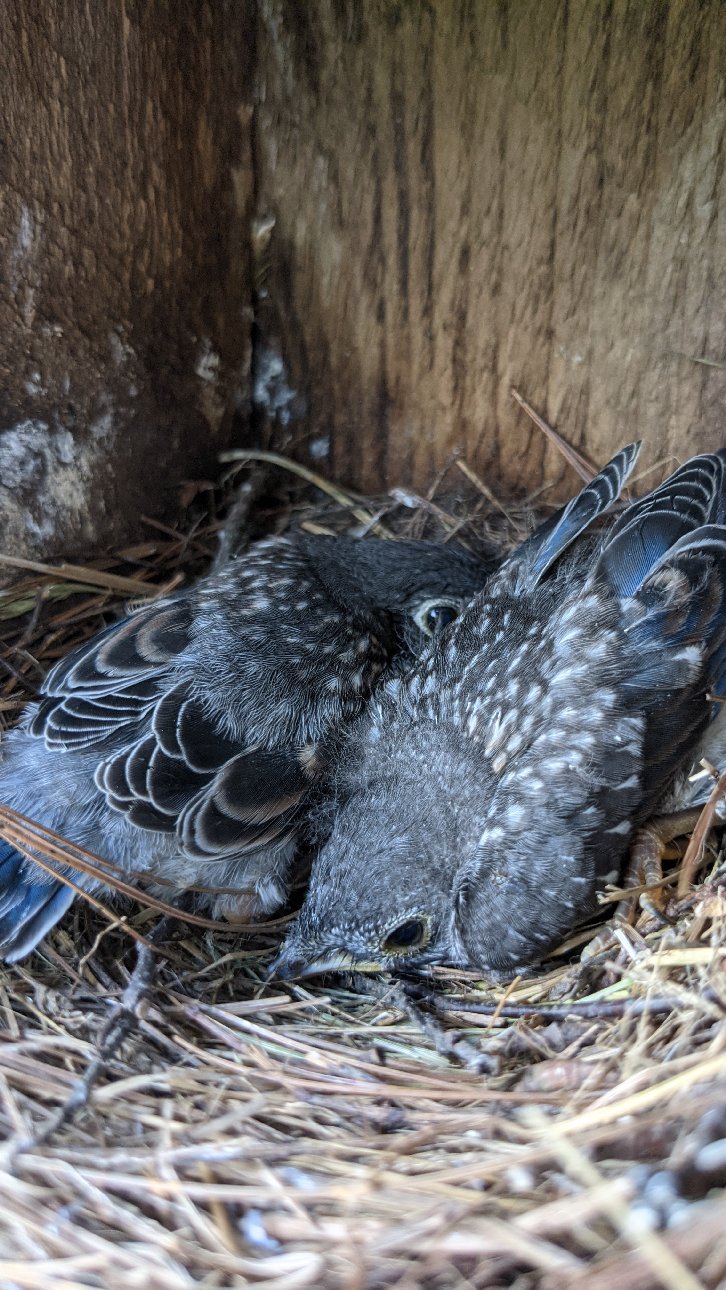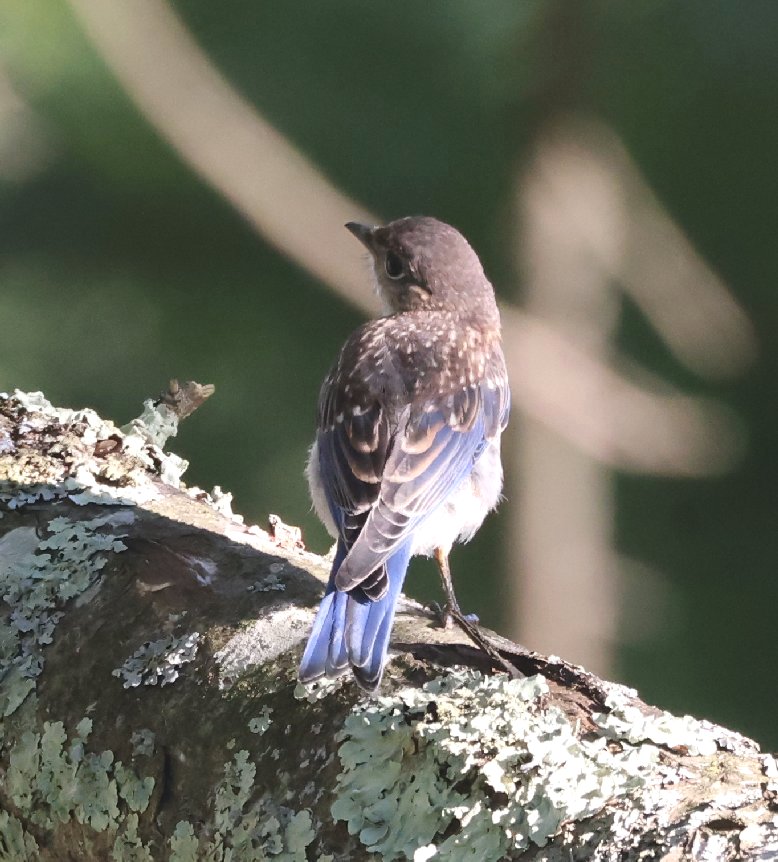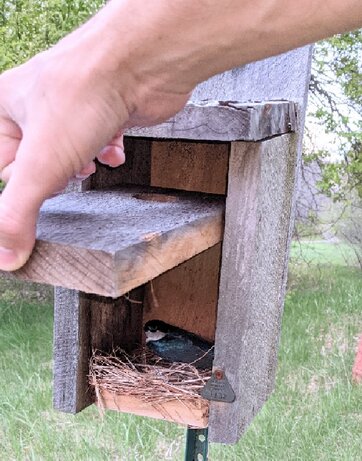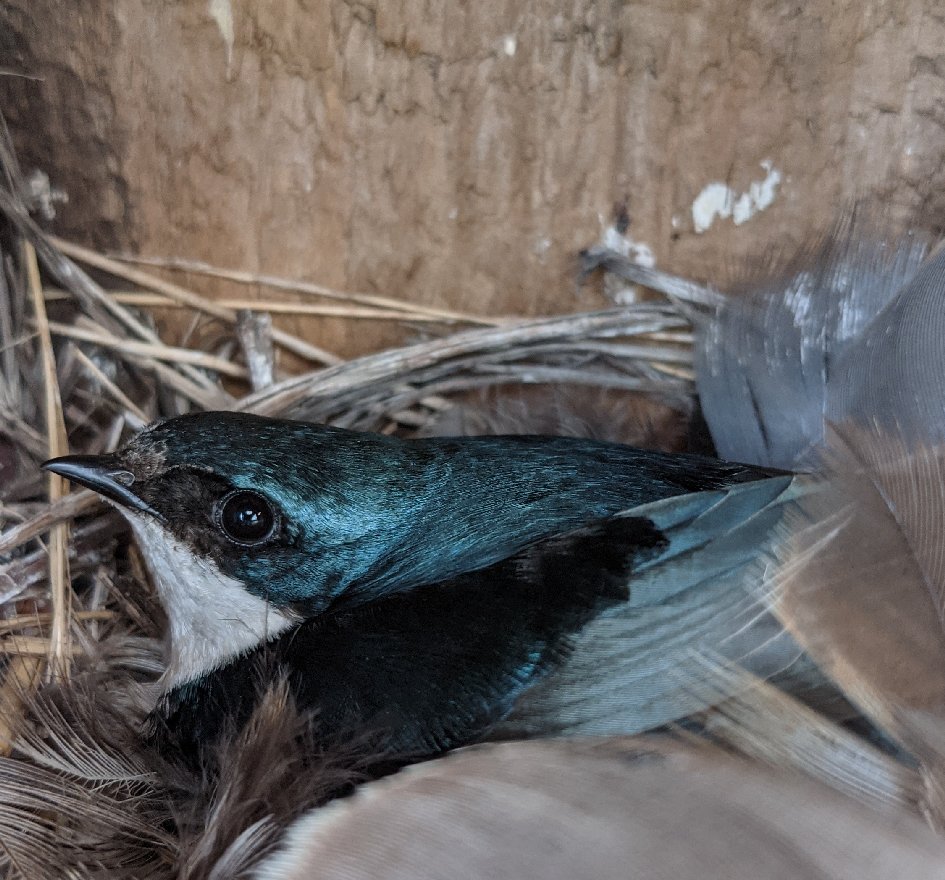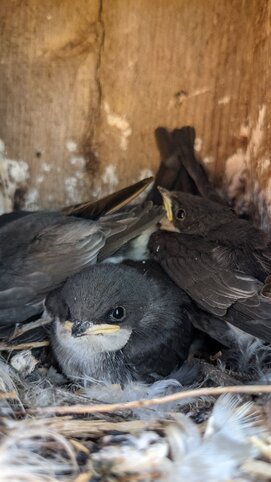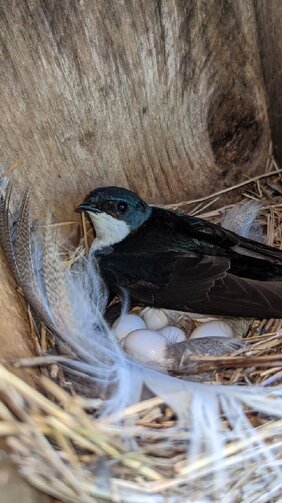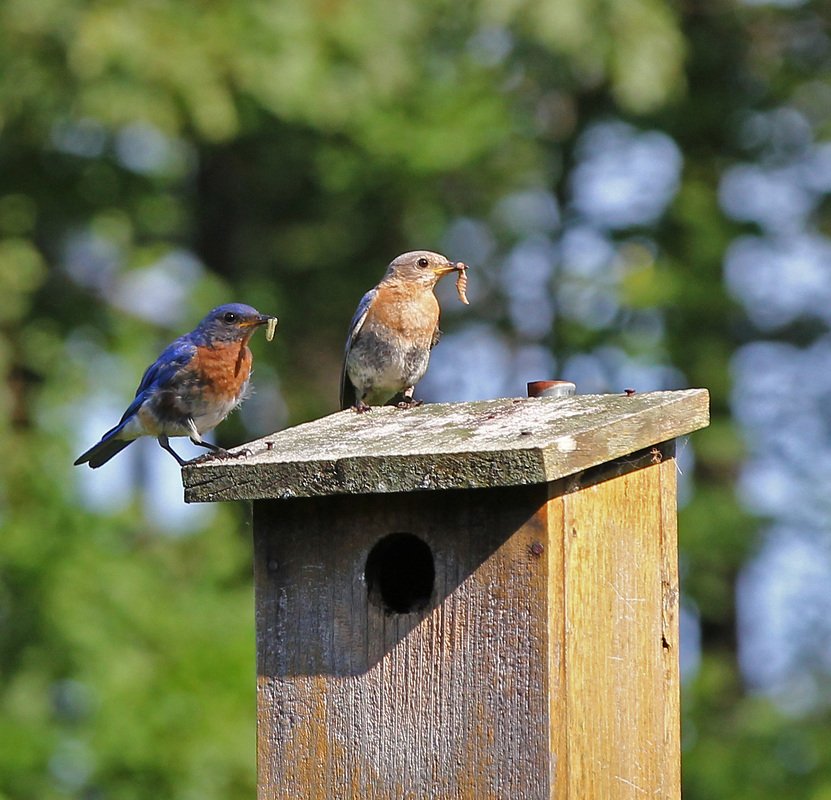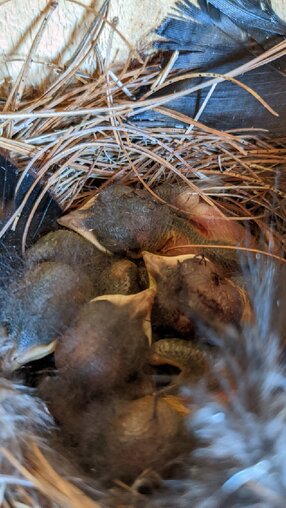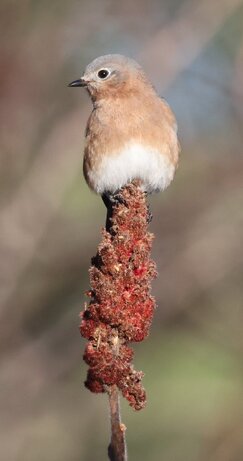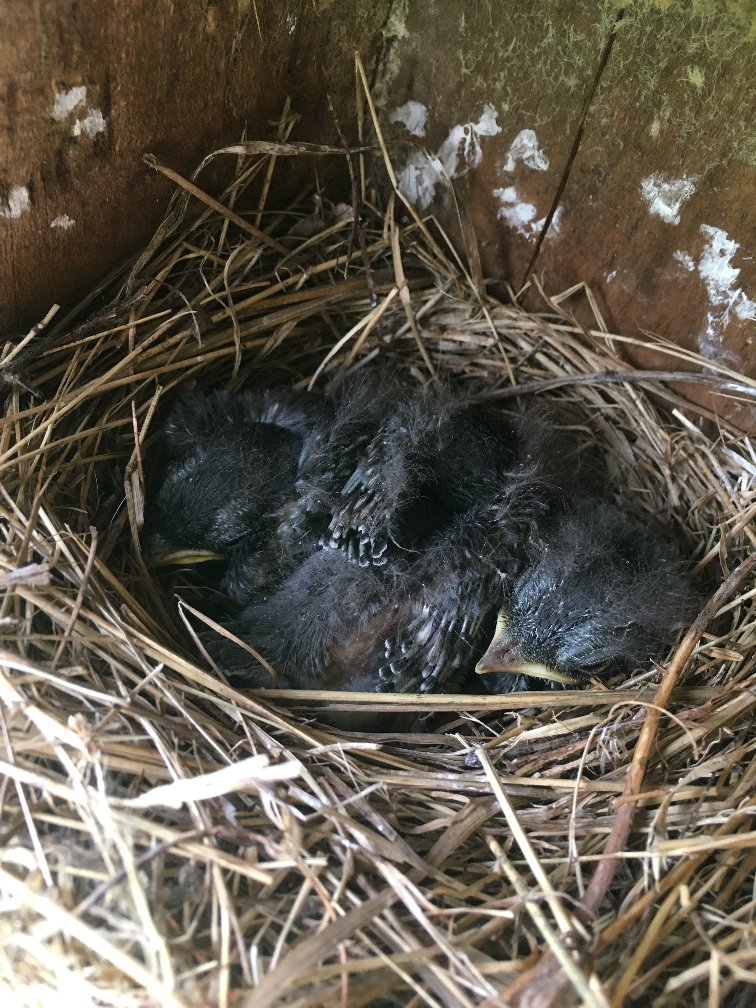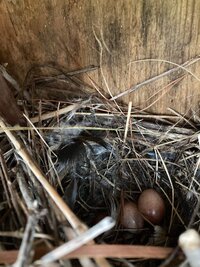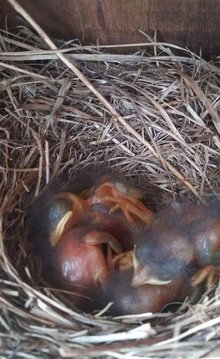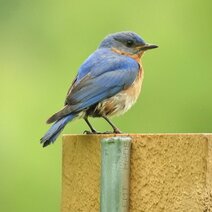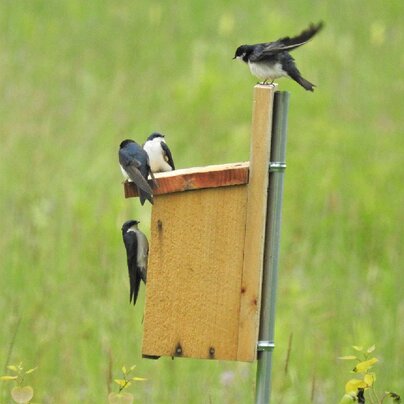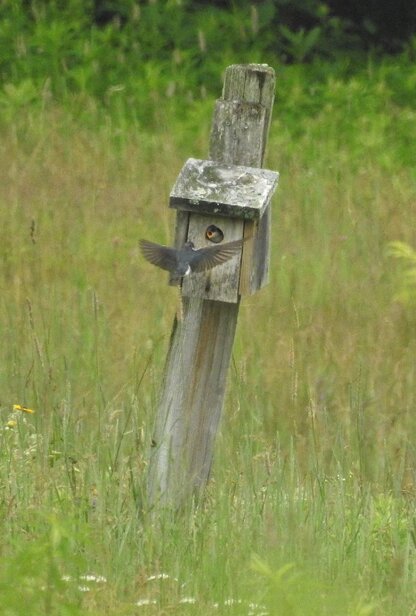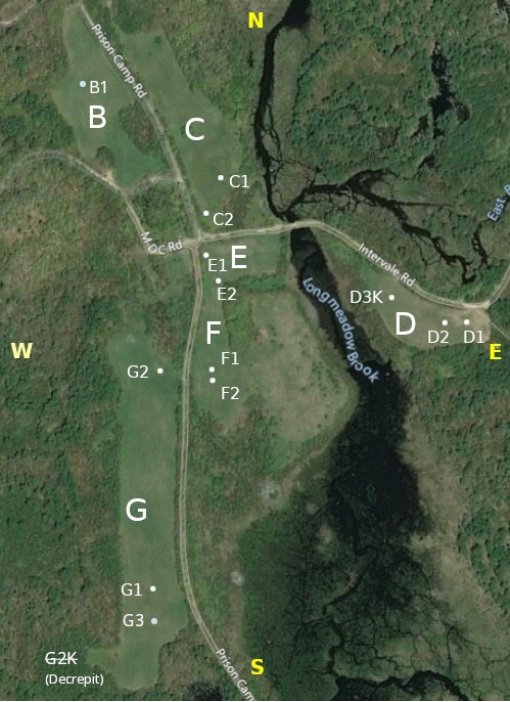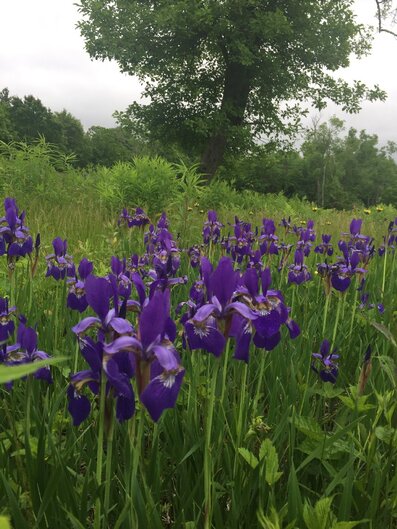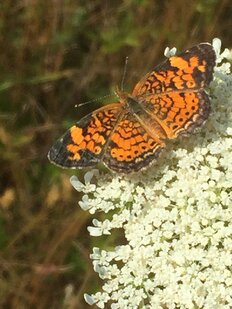OUR NATIVE CAVITY NESTERS:
AMERICAN KESTREL, EASTERN BLUEBIRD, TREE SWALLOW, BLACK-CAPPED CHICKADEE
Many of our cavity-nesting birds are in need of supplemental housing for a number of reasons:
How you can help:
- loss of dead and dying trees in the landscape
- competition from non-native House Sparrows and European Starlings, also cavity-nesters
- loss of old man-made structures such as barns and sheds, which some species are able to utilize as cavity-like nesting places
- loss of open, non-forested landscape and the edges around them
How you can help:
- Join us for nestbox construction workshops
- Assist with supervised installation of nestboxes
- Assist with observation and monitoring of kestrels and nestboxes placed throughout central Worcester County
- Report kestrel sightings to eBird or warerivernatureclub@yahoo.com
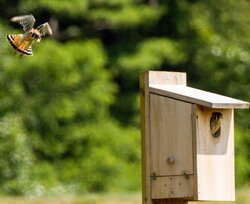 American Kestrel nesting at Wachusett Reservoir property, 2014.
Photo by Emily Eaton
American Kestrel nesting at Wachusett Reservoir property, 2014.
Photo by Emily Eaton
AMERICAN KESTRELS
Unlike the Eastern Bluebird, which has a healthy population here, American Kestrels have been in serious decline in Massachusetts for the past 10+ years. Kestrels need open grasslands for foraging and obtaining food. Efforts to assist with boosting their population include the placement of nestboxes in suitable habitat and/or where kestrels have historically nested or are observed. This effort has started to offer a glimmer of hope for attracting kestrels and increasing their nesting success, since the birds will utilize these structures when natural cavities aren't available.
Unlike the Eastern Bluebird, which has a healthy population here, American Kestrels have been in serious decline in Massachusetts for the past 10+ years. Kestrels need open grasslands for foraging and obtaining food. Efforts to assist with boosting their population include the placement of nestboxes in suitable habitat and/or where kestrels have historically nested or are observed. This effort has started to offer a glimmer of hope for attracting kestrels and increasing their nesting success, since the birds will utilize these structures when natural cavities aren't available.
|
HELPING BIRDS:
CITIZEN SCIENCE PROJECTS CLOSE TO HOME by State Ornithologist Andrew Vitz, Ph. D. Click here to see Drew's outline/slides from the presentation at the annual meeting on February 8, 2015. |
BLUEBIRD NESTBOX TRAIL
HIGH RIDGE
WILDLIFE MANAGEMENT AREA
GARDNER & WESTMINSTER
In the 1980's, under the direction of then-State Ornithologist Brad Blodgett, a bluebird "trail" was established at High Ridge Wildlife Management Area in Gardner/Westminster in the 1980s. Since then, Eastern Bluebirds have occupied 8 -10% of the nestboxes provided, with many of the rest being used by House Wrens, Tree Swallows,
and the occasional Black-capped Chickadee.
We are teaming up with MassWildlife to assist with the placement of
new boxes and maintenance and upkeep of the existing trail.
and the occasional Black-capped Chickadee.
We are teaming up with MassWildlife to assist with the placement of
new boxes and maintenance and upkeep of the existing trail.
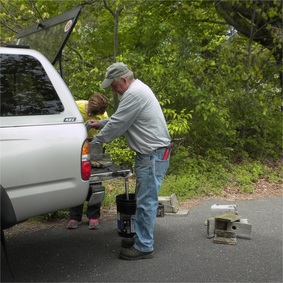
2015 - 2016 HIGH RIDGE WILDLIFE MANAGEMENT AREA BLUEBIRD TRAIL
UPDATE
During spring and early summer of 2015, with the guidance and direction of Bill Davis and Mike Morelly of MassWildlife, WRNC volunteers began inspecting, repairing, and replacing the nestboxes placed throughout this WMA. Starting at the eastern end in Westminster, we immediately encountered a number of boxes and posts that needed various levels of attention. In some cases all that was needed was a good cleanout. A few boxes that were still solid were on leaning posts or in some cases had slipped down the post and were near ground level. A pair of Tree Swallows using a box near the Intervale Road fields were bonded to one box that had slipped to the ground; we like to think that they were grateful to us for raising the box and tightening the brackets so they could better avoid predation.
At the time of this first visit in May, one box appeared to be occupied by Eastern Bluebirds, and in several others House Wrens or Tree Swallows had already taken up occupancy. In the cases of occupied houses, only pole-straightening or bracket-tightening was attempted. Nevertheless, there were many unoccupied nestboxes--many due to disrepair--so we had plenty of opportunity to put Larry Duprey's tools to work. Many thanks to Larry and Joan Duprey and their friend, Anne--all members of Athol Bird & Nature Club--for assisting with the first few dozen boxes that needed attention. We were off to a good start!
In late spring, Roxann Banks and Wendy Howes made further inroads, re-checking the first efforts and continuing up to the ridge to assess and clean out many more boxes. It was noted that many of the boxes were unoccupied due to vegetation encroachment,
so future efforts could include vegetation clearing and/or
placement of the nestboxes in more suitable locations.
On a July 9th visit to the Intervale Road/east side of the WMA we found that many of the nesting House Wrens were apparently starting a second brood, while most Tree Swallows were off the nest. However, a check of one box revealed four recently-hatched (1-3 days) Tree Swallow nestlings and a pair of watchful parent birds. This is a late nesting date for this species, an event that could be attributed to a number of of factors, but likely assuring a more reliable food supply.
John and Kathy Egan of Westminster volunteered themselves and their well-stocked tool kit for the 2106 season. We found ourselves in need of heavy-duty loppers, mallets, and people-power as well as replacement clamps and assorted hardware.
Thanks again to MassWildlife for making it possible
for us to drive in the WMA with all of this paraphernalia!
Stocked with several new boxes made by MassWildlife staff, we quickly re-checked the work of 2015 and cleaned unoccupied boxes out--many were stuffed with winter mouse nests--and continued even further into the WMA. Armed with the proper tools and the strength of our participants, we were able to clear some vegetation that was encroaching on the nestboxes and the field edges, and/or move the support posts. Several boxes were repaired on-site;
eight new boxes were installed.
At least one pair of bluebirds was seen, but most boxes were occupied by House Wrens and Tree Swallows,
not unusual in our area and in this WMA.
Thanks to John & Kathy for many hours spent on this project!
With the onset of hot weather, volunteer work was suspended, but we have plans to return in the fall.
Contact warerivernatureclub@yahoo.com if you are interested in helping.
When restoration and repair of the trail has been completed, we would like to deploy volunteers to monitor the trail and gather information about the nesting birds. If this is something you can do, please let us know.
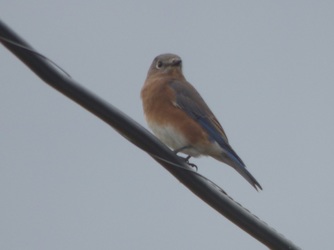
FALL 2016 NESTBOX REPORT--HIGH RIDGE WILDLIFE MANAGEMENT AREA
On October 16th three WRNC volunteers spent a final work day of the season at High Ridge WMA inspecting and cleaning nestboxes. Because of the weather and other factors this summer, there wasn’t a chance to do any monitoring during the season, but it was easy to figure out what went on with the boxes over the summer.
In spite of spring efforts to move some nestboxes away from deep "puckerbrush," and clean up overgrown vegetation at the base of many others, volunteers found evidence of an abundance of House Wrens. Considering how many wrens were encountered in the spring, this wasn’t a big surprise.
High Ridge is a terrific place for House Wrens, and uses of the boxes there by wrens is a natural response to the habitat. However, it was determined that in a few instances House Wrens had likely driven bluebirds or Tree Swallows from nests that had been begun by those species. There was no evidence of wrens killing adult or nestling bluebirds or swallows; however, wrens are known to destroy and carry off eggs of other cavity nesters, and there was no way to know if this had happened.
There are many nestboxes to choose from, so the evicted bluebirds and swallows found new homes. It was easy to determine the areas preferred by bluebirds and swallows, and evidence of successful nestings was found in many boxes. Next year perhaps 5-6 new nestboxes at the edges of the open areas preferred by swallows/bluebirds can be installed, and/or several unused nestboxes can be re-located to more suitable locations. A few boxes weren't being used by anything, not even mice.
On October 16th three WRNC volunteers spent a final work day of the season at High Ridge WMA inspecting and cleaning nestboxes. Because of the weather and other factors this summer, there wasn’t a chance to do any monitoring during the season, but it was easy to figure out what went on with the boxes over the summer.
In spite of spring efforts to move some nestboxes away from deep "puckerbrush," and clean up overgrown vegetation at the base of many others, volunteers found evidence of an abundance of House Wrens. Considering how many wrens were encountered in the spring, this wasn’t a big surprise.
High Ridge is a terrific place for House Wrens, and uses of the boxes there by wrens is a natural response to the habitat. However, it was determined that in a few instances House Wrens had likely driven bluebirds or Tree Swallows from nests that had been begun by those species. There was no evidence of wrens killing adult or nestling bluebirds or swallows; however, wrens are known to destroy and carry off eggs of other cavity nesters, and there was no way to know if this had happened.
There are many nestboxes to choose from, so the evicted bluebirds and swallows found new homes. It was easy to determine the areas preferred by bluebirds and swallows, and evidence of successful nestings was found in many boxes. Next year perhaps 5-6 new nestboxes at the edges of the open areas preferred by swallows/bluebirds can be installed, and/or several unused nestboxes can be re-located to more suitable locations. A few boxes weren't being used by anything, not even mice.
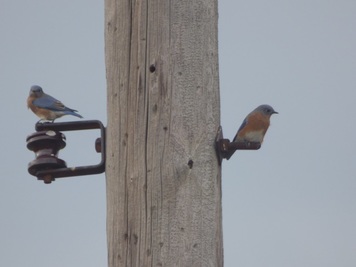
A small group of bluebirds and Cedar Waxwings were spotted close to the Barnstormers model aircraft area. There is plenty of fall fruit for them out there. There were probably at least three pairs of bluebirds nesting at High Ridge this season. We speculated that the bluebirds may not have attempted second nestings since the weather was so hot and dry. Nestbox contents reflecting second nestings --additional nesting material piled above a used nest—were not noted. On the other hand, there were many instances of wren nests built on top of previous bluebird or swallow nests.
Although Tree Swallows did nest all around the first large hayfield beyond the Overlook Street entrance, they didn't use boxes very much in the other areas, or had started nests in other areas but were “bumped” by wrens. Tree Swallow nestings appeared to be successful in that favored location, the discovery of two dead older nestlings and one unhatched egg notwithstanding.
Although Tree Swallows did nest all around the first large hayfield beyond the Overlook Street entrance, they didn't use boxes very much in the other areas, or had started nests in other areas but were “bumped” by wrens. Tree Swallow nestings appeared to be successful in that favored location, the discovery of two dead older nestlings and one unhatched egg notwithstanding.
Due to overall concerns about the about the status of Tree Swallow populations and their relatively low reproduction rate, we hope to place more boxes next to the largest open fields in 2017.
White-footed mice (Peromyscus leucopus) had taken up occupancy in several boxes; some boxes had unoccupied mouse nests. Where mice were present, they were left. The area is a natural location for mice, and they're an important part of the diet of the carnivorous mammals and birds of prey that use High Ridge WMA.
White-footed mice (Peromyscus leucopus) had taken up occupancy in several boxes; some boxes had unoccupied mouse nests. Where mice were present, they were left. The area is a natural location for mice, and they're an important part of the diet of the carnivorous mammals and birds of prey that use High Ridge WMA.
HIGH RIDGE NESTBOX TRAIL 2016-2020
In 2017-2018 volunteers John & Kathy Egan, Wendy Howes, and Alan Rawle continued with early spring and late fall maintenance of a nestbox trail that gradually grew to about 45 in number. Besides the usual cleaning and minor repairs, there were constant efforts at improvement, including upgrading with new boxes, trimming excessive undergrowth, and moving some posts and boxes to more suitable locations. The Club is ever indebted to multi-skilled volunteer John Egan, who has worked tirelessly to re-install and repair posts and boxes.
Due to a shortage of volunteers, there was little monitoring during the nesting season, so it was truly a combination of blind faith and biological detective work trying to piece together the level of nesting success for bluebirds and Tree Swallows. Each fall, some important information could be gleaned—the number of unused boxes, the number of boxes that probably fledged young, the large population of House Wrens, etc. But details were unknown.
In 2018 Donna Dickinson and Elaine Rodecki volunteered and were helpful in keeping the Club informed about maintenance issues, but formal monitoring was still lacking.
In 2019 Wendy Howes was able to check more than half of the nestboxes in mid-May and again on July 25th. The May inspections turned up a number of clues about the density of House Wrens and bluebird nest starts, but it was too early for definitive information. July’s findings were a bit more productive. At this late date most Tree Swallows would have finished nesting (they only nest once per season), and the appearance of the empty nests in many boxes indicated probable success with fledging young. One big surprise was a swallow nest with five eggs during the July check, a late date for this species. Of the 27 boxes inspected, two hosted bluebird pairs, and second broods were present in both boxes. Again there was clear evidence that House Wrens, which are very territorial, were problematic. Contributing to their density was the amount of overgrown and brushy vegetation close to the nestboxes.
Using a logical but informal numbering system, starting at the Overlook Road to the WMA entrance and continuing along east Gardner Road to May Street--a little over half of the nestboxes--not including the many on North Gardner Road--were observed. (Note: a 28th nestbox was added in 2020).
May 16, 2019
BOX # LOCATION NOTES
1 right empty
2 right empty
3 empty
4 right wren, active
5 right Looks like bluebird nest started; sticks on top (wren)
6 left Nest started, looks like bluebird
7 left Nest started, grass
8 Roadway on right, right empty
9 Roadway on right, Peterson box Nest started, grass
10 Overlook Road, right Stick (wren) nest, appears inactive, ?dummy nest
11 right, on pipe Box not opened; female bluebird present
12 Roadway on right, under maples; right empty
13 In open, near former building site Bluebird checking it
14 left Nest started, grass
15 right Nest started, grass
[ After drive through wooded section-East Gardner Road]
16 right, near hydrant Box not opened; bluebird pair present
17 left Nest started; full of grass but not shaped
18 right; hole enlarged Box not opened; male bluebird @ entrance; chickadee entering ? young present
19 Path on right; right at start empty
20 next on path, left empty
21 next on path, right Bluebird nest, no eggs
22 next on path, left Possible beginning of nest, no adult birds present
23 next on path, right empty
24 next on path Possible beginning of nest; no adult present
25 right Bluebird pair present; box not opened
26 empty
27 Possible beginning of bluebird nest
July 25, 2019
1 empty
2 empty
3 empty
4 Wren nest on top of grass nest
5 Active wren nest, second brood
6 Partial grass nest, probably bluebird; unused
7 Box not opened
8 Wren had started; Tree Swallow built on top;
one unhatched egg, otherwise probably successful
9 Messy, used Tree Swallow nest; apparently successful
10 Active wren nest; second brood
11 Box not opened; bluebirds present and active; second brood
12 Used Tree Swallow nest; apparently successful
13 empty
14 Used Tree Swallow nest; apparently successful
15 Active wren nest; second brood
16 Used Tree Swallow nest; apparently successful
17 left empty
18 Possible chickadee nest, then bluebird nest on top; ?outcome
19 Bluebird pair present; probable second brood
20 ? wren nest or dummy
21/22 One had active wren nest; the other unknown (numbering error)
23 empty
24 Used Tree Swallow nest; apparently successful
25 Clean pine needle nest, ? unused
26 Active Tree Swallow nest w/ 5 eggs; unusually late nesting
27 Used Tree Swallow nest; apparently successful
During winter 2019-2020, Mass Wildlife made some major changes to the landscape by mowing some weedy patches alongside the trails that had begun to sprout woody vegetation and briars. In addition, the overgrown roadsides were cut back significantly, and briars and shrubby growth along stone walls was cut. This opened up the landscape, and while it wasn’t an “improvement” from the wrens’ point of view, the habitat is now much more suited to the needs of Tree Swallows and Eastern Bluebirds.
In 2020, volunteers managed to get the early spring maintenance visit accomplished just before the onset of pandemic restrictions.
In 2017-2018 volunteers John & Kathy Egan, Wendy Howes, and Alan Rawle continued with early spring and late fall maintenance of a nestbox trail that gradually grew to about 45 in number. Besides the usual cleaning and minor repairs, there were constant efforts at improvement, including upgrading with new boxes, trimming excessive undergrowth, and moving some posts and boxes to more suitable locations. The Club is ever indebted to multi-skilled volunteer John Egan, who has worked tirelessly to re-install and repair posts and boxes.
Due to a shortage of volunteers, there was little monitoring during the nesting season, so it was truly a combination of blind faith and biological detective work trying to piece together the level of nesting success for bluebirds and Tree Swallows. Each fall, some important information could be gleaned—the number of unused boxes, the number of boxes that probably fledged young, the large population of House Wrens, etc. But details were unknown.
In 2018 Donna Dickinson and Elaine Rodecki volunteered and were helpful in keeping the Club informed about maintenance issues, but formal monitoring was still lacking.
In 2019 Wendy Howes was able to check more than half of the nestboxes in mid-May and again on July 25th. The May inspections turned up a number of clues about the density of House Wrens and bluebird nest starts, but it was too early for definitive information. July’s findings were a bit more productive. At this late date most Tree Swallows would have finished nesting (they only nest once per season), and the appearance of the empty nests in many boxes indicated probable success with fledging young. One big surprise was a swallow nest with five eggs during the July check, a late date for this species. Of the 27 boxes inspected, two hosted bluebird pairs, and second broods were present in both boxes. Again there was clear evidence that House Wrens, which are very territorial, were problematic. Contributing to their density was the amount of overgrown and brushy vegetation close to the nestboxes.
Using a logical but informal numbering system, starting at the Overlook Road to the WMA entrance and continuing along east Gardner Road to May Street--a little over half of the nestboxes--not including the many on North Gardner Road--were observed. (Note: a 28th nestbox was added in 2020).
May 16, 2019
BOX # LOCATION NOTES
1 right empty
2 right empty
3 empty
4 right wren, active
5 right Looks like bluebird nest started; sticks on top (wren)
6 left Nest started, looks like bluebird
7 left Nest started, grass
8 Roadway on right, right empty
9 Roadway on right, Peterson box Nest started, grass
10 Overlook Road, right Stick (wren) nest, appears inactive, ?dummy nest
11 right, on pipe Box not opened; female bluebird present
12 Roadway on right, under maples; right empty
13 In open, near former building site Bluebird checking it
14 left Nest started, grass
15 right Nest started, grass
[ After drive through wooded section-East Gardner Road]
16 right, near hydrant Box not opened; bluebird pair present
17 left Nest started; full of grass but not shaped
18 right; hole enlarged Box not opened; male bluebird @ entrance; chickadee entering ? young present
19 Path on right; right at start empty
20 next on path, left empty
21 next on path, right Bluebird nest, no eggs
22 next on path, left Possible beginning of nest, no adult birds present
23 next on path, right empty
24 next on path Possible beginning of nest; no adult present
25 right Bluebird pair present; box not opened
26 empty
27 Possible beginning of bluebird nest
July 25, 2019
1 empty
2 empty
3 empty
4 Wren nest on top of grass nest
5 Active wren nest, second brood
6 Partial grass nest, probably bluebird; unused
7 Box not opened
8 Wren had started; Tree Swallow built on top;
one unhatched egg, otherwise probably successful
9 Messy, used Tree Swallow nest; apparently successful
10 Active wren nest; second brood
11 Box not opened; bluebirds present and active; second brood
12 Used Tree Swallow nest; apparently successful
13 empty
14 Used Tree Swallow nest; apparently successful
15 Active wren nest; second brood
16 Used Tree Swallow nest; apparently successful
17 left empty
18 Possible chickadee nest, then bluebird nest on top; ?outcome
19 Bluebird pair present; probable second brood
20 ? wren nest or dummy
21/22 One had active wren nest; the other unknown (numbering error)
23 empty
24 Used Tree Swallow nest; apparently successful
25 Clean pine needle nest, ? unused
26 Active Tree Swallow nest w/ 5 eggs; unusually late nesting
27 Used Tree Swallow nest; apparently successful
During winter 2019-2020, Mass Wildlife made some major changes to the landscape by mowing some weedy patches alongside the trails that had begun to sprout woody vegetation and briars. In addition, the overgrown roadsides were cut back significantly, and briars and shrubby growth along stone walls was cut. This opened up the landscape, and while it wasn’t an “improvement” from the wrens’ point of view, the habitat is now much more suited to the needs of Tree Swallows and Eastern Bluebirds.
In 2020, volunteers managed to get the early spring maintenance visit accomplished just before the onset of pandemic restrictions.
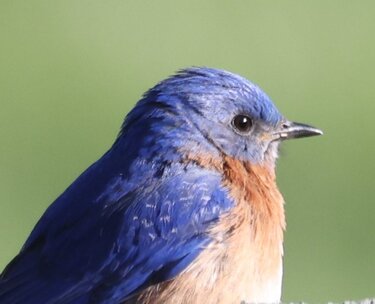 Photo by Alan Rawle
Photo by Alan Rawle
2021
NEW VOLUNTEER NEST BOX MONITOR ON BOARD!
In 2021 we welcomed Jon Skinner as the new volunteer monitor at this location. Jon jumped in with both feet and joined us for maintenance and repair in early April. Throughout the nesting season he made regular visits, usually weekly, recording information in eBird and on his own information software.
That fall, Jon created a custom map of the nestbox locations.
To view Jon's Google map of the nestboxes at High Ridge WMA,
click HERE
NEW VOLUNTEER NEST BOX MONITOR ON BOARD!
In 2021 we welcomed Jon Skinner as the new volunteer monitor at this location. Jon jumped in with both feet and joined us for maintenance and repair in early April. Throughout the nesting season he made regular visits, usually weekly, recording information in eBird and on his own information software.
That fall, Jon created a custom map of the nestbox locations.
To view Jon's Google map of the nestboxes at High Ridge WMA,
click HERE
|
The 2021 nesting season was off to a good start in May with at least seven bluebird nests found in mid- May. The nests were at different stages, with nestlings in three boxes and full clutches of eggs in four boxes. Of nests found in 21 boxes, a few more seemed to be additional bluebird nests, but many were incomplete and could have been begun by Tree Swallows, the most populous resident of nestbox trail. |
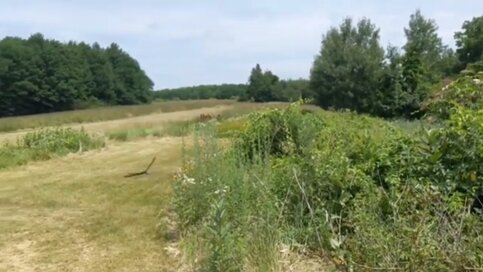
House Wrens are common at the WMA. Because of their aggressive nature and tendency to fill nearby empty boxes with twigs—“dummy” nests—efforts are being made to place some nestboxes in brushy areas attractive to wrens, with the hope that the birds will be lured to sites away from the open fields preferred by swallows and bluebirds. A couple of boxes with smaller, wren-size holes were added to the trail this year. One of the boxes was quickly occupied by wrens, but the choice for the box location turned out to be poor. As the wren nestlings were nearing fledging, one or more adult wrens attacked and killed an adult swallow and two nestlings in a nearby box. Fortunately, Jon was monitoring the boxes soon afterward and, along with discovering the sad situation, he found a third nestling that was still alive and brought it to a licensed rehabilitator. It was thought that the nestling would survive in spite of its injuries. The bird indeed recovered, and the rehabilitator released it back at the Wildlife Management Area on July 18th . If you have a Facebook account, you can view the post here: https://www.facebook.com/ADEYWILDLIFEREHABILITATION/posts/4240690619322712
The rehabilitator wrote: The tree swallow that arrived as an injured nestling and was the lone survivor of a nest box attack fully recovered and is all grown up. He was able to fly extremely well and could easily eat bugs on the fly, so he was able to return home.
He took off like a dart! [He was released at the WMA property.] It’s the exact location he came from.
In a still shot from the video (upper left), you can make out the bird in flight. You’ll have to take our word for it that it is a Tree Swallow; it was flying away fast when the video was shot.
The end of June brought more misfortune to some other pairs of nesting swallows when a bear (or bears) pulled over and destroyed five nestboxes. At least some of the boxes had active swallow nests that were lost.
The rehabilitator wrote: The tree swallow that arrived as an injured nestling and was the lone survivor of a nest box attack fully recovered and is all grown up. He was able to fly extremely well and could easily eat bugs on the fly, so he was able to return home.
He took off like a dart! [He was released at the WMA property.] It’s the exact location he came from.
In a still shot from the video (upper left), you can make out the bird in flight. You’ll have to take our word for it that it is a Tree Swallow; it was flying away fast when the video was shot.
The end of June brought more misfortune to some other pairs of nesting swallows when a bear (or bears) pulled over and destroyed five nestboxes. At least some of the boxes had active swallow nests that were lost.
HIGH RIDGE WMA - 2022
John Egan and Jon Skinner hit the ground running at High Ridge Wildlife Management Area in April, repairing and re-siting 48 nestboxes while bluebirds and early-arriving Tree Swallows flew around excitedly, ready to claim a nest site. Attempts were being made to make the boxes less attractive to House Wrens (nestbox competition) and black bears (predation). Nestboxes were re-numbered and marked this season. Jon was assisted by fellow birders Will Durkin and Valerie Burdette in observing and monitoring this season.
John Egan and Jon Skinner hit the ground running at High Ridge Wildlife Management Area in April, repairing and re-siting 48 nestboxes while bluebirds and early-arriving Tree Swallows flew around excitedly, ready to claim a nest site. Attempts were being made to make the boxes less attractive to House Wrens (nestbox competition) and black bears (predation). Nestboxes were re-numbered and marked this season. Jon was assisted by fellow birders Will Durkin and Valerie Burdette in observing and monitoring this season.
|
In an unfortunate repeat performance in July, boxes # 42 and 44 - 48 were out of commission for the last few weeks of the season due to bear activity. Several boxes were destroyed here in 2021. Whether the boxes will be relocated has not yet been decided. Tree Swallows tend to have good success at this location when bears are not an issue.
Summary and highlights: EABL Nesting Statistics:
TRES Nesting Statistics:
|
Jon compiled the data in a spreadsheet, and it's sorted by nestbox number. For details go to:
https://docs.google.com/spreadsheets/d/1-W5L6jiQLMk-AHZHmBGnMHlJrLpEv__flut5wPumFic/edit?usp=sharing
https://docs.google.com/spreadsheets/d/1-W5L6jiQLMk-AHZHmBGnMHlJrLpEv__flut5wPumFic/edit?usp=sharing
|
|
|
SPRING/SUMMER 2021
Many thanks to Club volunteers Doug Wipf and Ted Purcell, who monitored 11 Eastern Bluebird / Tree Swallow nest boxes in the vicinity of Intervale Rd. & Prison Camp Road at DCR's Ware River Watershed property in Rutland. This season Doug started making regular observations on April 30th. Doug created this report and the map at right, which shows showing the fields and box locations. The boxes are mapped according to the various fields (Fields C, D, E, F, G) in which they are placed. The success of each box was difficult to discern as boxes were not approached and opened this season. Box C1: Successful. Used by Tree Swallows and at least one nestling was observed being fed at the box’s entrance hole. Box C2: Unused. A new box installed this season. Tree Swallows investigated the box soon after installation, but no further activity was observed. Box D1: Successful. Eastern Bluebird seemed interested in this box on 4/30, but thereafter it was all about Tree Swallows. Then on 6/25, a Tree Swallow was seen leaving the box with a fecal sac, confirming success. Box D2: Successful. Eastern Bluebirds nested early and the nesting attempt appeared successful 5/20 & 5/27, when bluebirds were seen hunting and bringing food to the nest box. Box D3K (kestrel box): Unused. Though not used for nesting, it was a popular box throughout the season. Several species – Eastern Bluebird, Tree Swallow, Brown-headed Cowbird, a Northern Flicker, and a Song Sparrow, observed perching or gathering on/around the box. Box E1: Successful. This box was installed this season. Was first inspected by Tree Swallows but eventually Eastern Bluebirds nested. On 6/16 an Eastern Bluebird was seen bringing food to the box. At least 3 bluebirds were at & in the box on 6/25.
Box E2: Successful. This newly installed box hosted Tree Swallows in what appeared to be a successful nesting attempt. A pair of Tree Swallows were defending the box from a persistent House Wren on 6/16; on 6/22, apparent feeding activity at the box; and on 6/25 there were at least 5 Tree Swallows in & on the nest box. Box F1: Unknown. Tree Swallows were often in, on, and near this box, and sometimes feeding in the area. However, there were no clear signs of nesting attempts. Box F2: Successful. Tree Swallows very busy around this nest box, and on 6/16 & 6/20 were appeared to be bringing food to the box. On 6/25, 5 Tree Swallows were active in, on, and around, this box. Box G1: Successful. Eastern Bluebirds apparently successful in this nesting attempt. During one observation, bluebirds appeared to be defending the box against interested Tree Swallows. On 5/27, an Eastern Bluebird was seen bringing food to the box. Box G2: Unknown. Tree Swallow activity often seen in & around this box, but no definite signs of a nesting attempt. DCR WATERSHED |
SPRING/SUMMER 2022
Doug and Ted continued their excellent monitoring work here, this season monitoring 13 Eastern Bluebird / Tree Swallow nest boxes starting on May 3rd. The fields were visited 10 times, down from 14 visits in 2021. Unlike past seasons, this year several of the boxes were opened for inspection. Doing so was helpful and should continue. Box B1: Apparently successful. Field B and its box were added in 5/3/22, replacing a decrepit & unused box. On 6/11/22, Eastern Bluebird nestlings were inside. It was hard to determine the exact number, but there were at least two and probably more. No final count, and no other activity was reported at this box. Box C1: Undetermined. Tree Swallows were often seen looking out from inside, entering and leaving, on and around the box. Box C2: Possibly successful. This box was on the ground; cleaned and reset 5/3/22. On 6/11/22, Tree Swallows appeared to be bringing food to this box. Box D1: Apparently successful. Six Tree Swallow nestlings photographed inside the box on 6/11/22. No further activity recorded. Box D2: Apparently successful. House Wrens used the box and four – five eggs were observed 5/11/22. A House Wren was seen bringing food to the nest box 6/25/22. No further activity recorded. Box D3K (kestrel box): Unused; no activity was observed here this year. Box E1: Failed Eastern Bluebird nesting attempt. Bluebird nest observed in the box 5/3/22. Four bluebird eggs in the nest on 5/15/22, but one appeared damaged. On 6/11/22, observation showed House Wrens had taken over the box and built a nest on top of the bluebird nest. No further activity recorded. Box E2: Successful. Tree Swallows were observed in and around the box from 5/15/22 – 6/11/22, and swallows were seen bringing food to the box. On 6/25/22, three Tree Swallows were in, on, and around the nest box. Box F1: Unknown. The box & post were on the ground; they were removed & replaced 5/3/22. Like last year, Tree Swallows were often in, on, and near this box, and sometimes feeding in the area. However, there were no clear signs of a nesting attempt. Box F2: Successful. Like last year, Tree Swallows were busy around this nest box, and on 5/15, 5/30 & 6/11/22, appeared to be bringing food to the box. On 6/25/22, 8 Tree Swallows were observed in, on, and around the box. Box G1: Unknown. Eastern Bluebird nest seen in the box 5/3/22, but it might have been an unfinished Tree Swallow nest. The rest of the season, Tree Swallows were in, on, and around the box. On 6/25/22, six Tree Swallows seen at the box. Box G2: Unknown. House Wren nest removed 5/3/22. No activity observed until 5/30/22, when two Eastern Bluebirds appeared to be shuttling food. On 6/11/22, a Tree Swallow was in the box, peeking out. Perhaps bluebirds fledged after 5/30/22? On 6/25/22, a Tree Swallow appeared to be bringing food to the box. 7/13/22, House Wren singing from atop the nest box. On 8/1/22, two House Wrens were seen - one peeking out from inside, the other singing nearby, then it entered the nest box. Box G3: Possibly successful. New nest box installed 5/3/22. Tree Swallows appeared to be bringing food 6/11 & 6/25/22. On 7/13/22, a Tree Swallow was inside peeking out, and on 7/16/22, three to four Tree Swallows were seen in and around the box. At the beginning of June, DCR land managers applied herbicides to portions of the property to quell the persistent non-native invasives such as multiflora rose and oriental bittersweet that are encroaching into the former hayfield. Personal circumstances and then the extremely hot weather that descended upon central MA prevented further monitoring visits until July 24th, when Mike tried to beat the heat by going early in the day. Boxes were not opened for inspection No cavity nesters were noted, which was no surprise given the hot and dry conditions. Also, swallow and first bluebird broods would have fledged by that date. On October 18th, the nestboxes, except for two that held mouse nests, were cleaned out. Eight bluebirds were seen around the property. |
